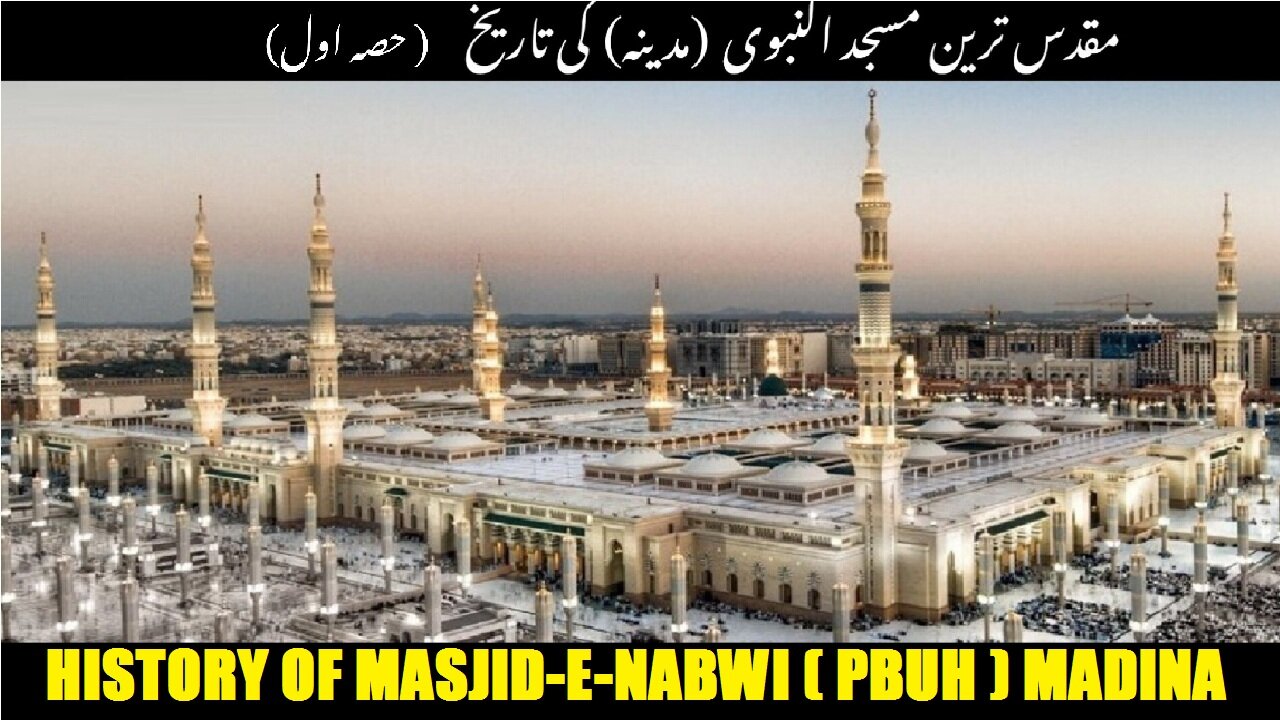Premium Only Content

Part-1 | History of Masjid Al-Nabwi at Madina | مدینہ منورہ میں مسجد نبوی کی تاریخ
@islamichistory813 #holiestsites #hostoricmosques #MasjidNabwi #IslamicHistory #Madina
Part-1 History of Masjid Al-Nabwi at Madina
Asslamoalaikum sisters brothers friends and elders, Please be with us upto end of this video as we are describing the captivating history of Masjid Nabwi (SAW) in Madina. This video offers a compelling narrative of the mosque's origins, development, and enduring legacy, shedding light on its profound importance in the Islamic faith.
A model of the original mosque, at Dar al Medina, built by prophet Muhammad after he arrived in Medina following Hejrah from Mecca. The land was owned by Sahal and Suhayl, partly as a place for drying dates, and at one end had been previously used as a burial ground. Refusing to "accept the land as a gift", he bought the land and it took seven or eight months to complete.
Yathrib was the pre-Islamic name of the city that later became known as Medina. The renaming of Yathib city to Madinat al-Nabi (meaning "The City of the Prophet") occurred circa 623-24 CE after the Prophet Muhammad's migration from Mecca to Yathrib a year earlier in 622 CE.
In 622 CE, following his migration to ancient Yathrib, which was already an ancient oasis town inhabited for some 1500 years at the time, the development of an early concept of a Muslim state began to take shape. During this peiod a number of "public" buildings were constructed, including the Masjid an-Nabawi, and the Prophet Muhammad personally oversaw the construction of the mosque. Mounted on his camel named Qaswa, he reached the site, part of which was initially functioning as a burial ground. Remarkably, when offered the land as a gift by the two orphans, Sahl and Suhayl, who were its owners, Muhammad declined the generous gesture. Instead, he opted to purchase the land, with the financial support provided by Abu Ayyub al-Ansari.
The entire construction process spanned seven months, during which the mosque took shape under the careful guidance of Prophet Muhammad. The Masjid Nabawi, commonly known as the Prophet's Mosque, was initially an open air mud-brick and stone wall enclosure. The simple masjid underwent many phases of expansion, the first being seven years after its construction, during the lifetime of prophet Muhammad
This initiative not only established a sacred space for worship but also showcased his humility and commitment to the establishment of a basic social and administrative paradigm in the Medinan society. The mosque's inception marked a significant moment in the history of Islam, serving as a pivotal center for spiritual, social, and administrative activities in the burgeoning Muslim community of Medina.
Initial Plan and Orientation
The original mosque was 35 meters long and 30 meters wide. The layout or floor plan of the mosque complex in its first iteration of the mosque depicts how it might have looked in the first year of Hijrah, back then it was oriented north-south. The qiblah wall was to the north facing the Masjid al-Aqsa; where nearly half of the mosque enclosure was covered with a roof of date-palm leaves, supported by data-palm tree trunks and the rest of the enclosure was left as open air courtyard except for a small roofed area to the south, called al-Suffah. This small area was also roofed with date palm leaves and beaten clay. However, it is not certain if the raised platform of al-Suffah was constructed along the entire southern wall or in part. Since, the Qibla (prayer direction) remained towards the Jerusalem (al-Quds) for the next 18 months, the mosque also remained north-south oriented for the same period.
Construction Details
The initial construction of Masjid Nabawi started in the month of Rabi al-Awwal, in mid year 1 Hijri (circa 622 CE), with the Prophet Muhammad himself taking part in laying its foundations and its development. He marked out the boundary of the site using the tip of a spear he inherited from his father, Abdullah.
The enclosure of the mosque was constructed with unbaked bricks as building material on top of a stone-masonry foundation which was about 1.5 metres high. Parts of the enclosure walls were constructed with stones and mud was used to plaster the walls.
The roof which was supported by date and palm tree trunks was made of beaten clay and palm leaves. It was raised to the height of 2.17 meters (7.11 feet) and slightly sloped to facilitate drainage during the rainy season. The three doors of the mosque were Bab-al-Rahmah (The Door of Mercy) to the south, Bab-al-Jibril (Door of Gabriel) to the west and Bab al-Nisa (Door of the Women) to the east. Originally these gates bore no names. The total area was some 1,050 square metres. The original mosque of the Prophet did not have a mehrab, the first mihrab might have originated during the reign of Umayyad prince al-Wal?d I (705–715 CE).
During this time prophet Muhammad was married to Sawdah bint Zam'a and Aiesha bint Abi Bakr, so at least two separate chambers, living quarters of the Prophet Muhammad and his wives, were built on the south-eastern corner adjacent to the mosque.
So dear friends, remaining history of Masjid Nabwi will be described from here in next video part-2 inshahAllah tomorow same time. Allah Hafiz
===============================
-
 LIVE
LIVE
Dr Disrespect
5 hours ago🔴LIVE - DR DISRESPECT - NEW PC VS. DELTA FORCE - MAX SETTINGS
3,318 watching -
 1:02:51
1:02:51
In The Litter Box w/ Jewels & Catturd
21 hours agoWhere are the Epstein Files? | In the Litter Box w/ Jewels & Catturd – Ep. 750 – 2/26/2025
30.7K22 -
 LIVE
LIVE
Revenge of the Cis
2 hours agoLocals Episode 198: Suits
516 watching -
 1:38:56
1:38:56
SLS - Street League Skateboarding
1 day agoTop Moments from the Second Half of the 2024 SLS Championship Tour! All The 9’s 🔥
12K1 -
 24:22
24:22
Breaking Points
5 hours agoHouse GOP RAMS THROUGH Medicaid Cuts
17.7K13 -
 1:24:15
1:24:15
The Quartering
4 hours agoRep. Swalwell's VIRAL Confrontation, Jeff Bezos Op-Ed Announcement, and Canada's Anti-Musk Campaign
75.6K21 -
 1:22:57
1:22:57
Tucker Carlson
7 hours agoNancy Pelosi Stock Tracker Chris Josephs: How to Get Rich by Investing Like a Politician
125K47 -
 2:59:34
2:59:34
Barry Cunningham
6 hours agoWATCH LIVE: DOGE SUBCOMMITTEE HEARING!
49.4K27 -
 1:29:32
1:29:32
Simply Bitcoin
5 hours ago $3.56 earnedNEW REPORT PROVES This Bitcoin Bull Run is DIFFERENT!! | EP 1191
51.8K -
 1:23:50
1:23:50
Russell Brand
6 hours agoAI Visions, War Deals, and the Next Big Lockdown? – SF544
130K19